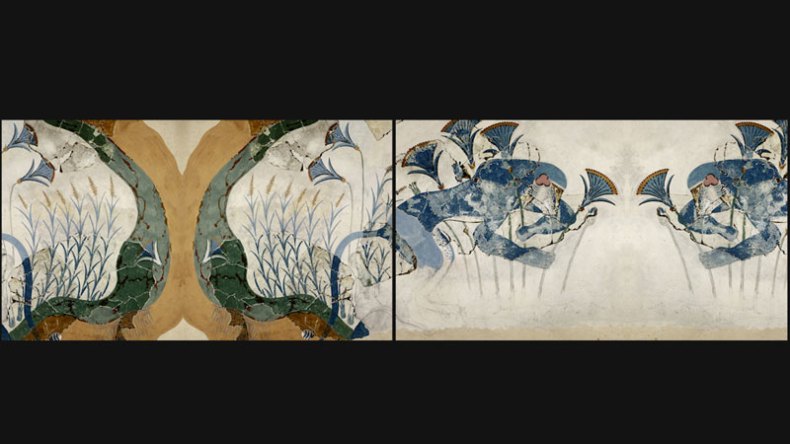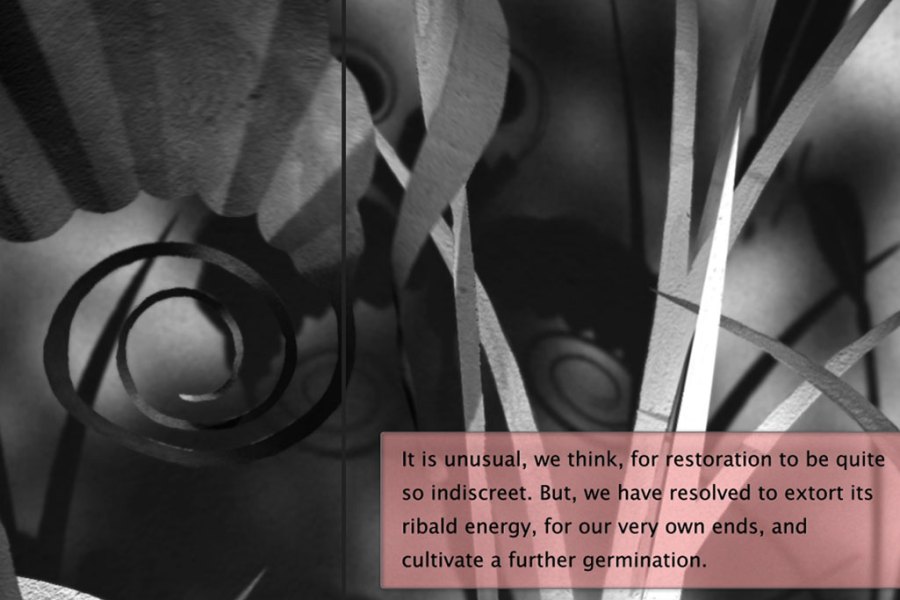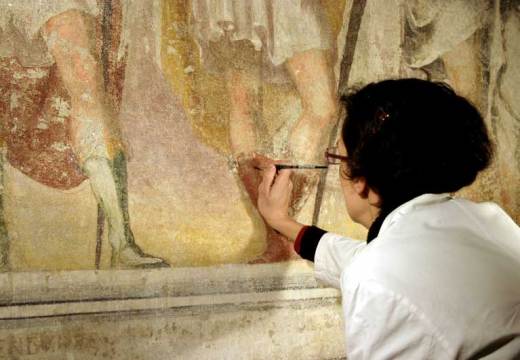It is hard to know precisely where to start with A Restoration, except with a recommendation to go and see it. Beyond that, things get tricky: it is a piece so fecund and engaging that focusing on any one of the lines of thought it provokes risks misrepresenting it, or at least underplaying its immense appeal to a viewer.
For the basics, A Restoration is simple enough: it is a 20-minute video crafted by artist Elizabeth Price from her forays into the collections of Oxford’s Ashmolean and Pitt Rivers museums. Central among these is the archive of Sir Arthur Evans – former Keeper of the Ashmolean, and discoverer of Knossos in Crete, the supposed home of the mythical Labyrinth. Evans’ work at Knossos provides the theme of Price’s video, which, like Evans himself, indulges in an audacious act of extrapolation from fragmentary materials.

A RESTORATION (2016), Elizabeth Price, two-screen video still. (2016), Elizabeth Price, two-screen video still. Courtesy of the artist and MOT International London and Brussels
Evans’ controversial step was to ‘restore’ Knossos. According to his own image of what the ancient city was like, he raised structures on shaky hypotheses, recreated frescoes from tiny remnants, and either resurrected an ancient civilisation, or desecrated the only evidence as to what it was really like. Like more than one instance of conservational overstepping, Knossos seems to show restoration as its own opposite: a form of damage.
Price uses that paradox to probe what restoration means, but also to indulge her own impulses to restore, whatever the consequences. The archives soon become the occasion for her to do her own extrapolatory ‘restoration’, which twists and turns through archaeology, museology, semiology, and even data-entry workflow, towards a kind of orgiastic celebration among Knossos’ rebuilt ruins. Over a soundtrack of Price’s own music, a computer-generated voice speaks for the ‘Chorus’, narrating the viewer’s journey through the archives, towards the gathering at Knossos itself. As a whole, film, soundtrack and text lock together into something that is as close to the Wagnerian dream of a Gesamtkunstwerk as I have ever experienced.

A RESTORATION (2016), Elizabeth Price, two-screen video still. Courtesy of the artist and MOT International London and Brussels
Narrative is important to Price. She refers to it both as a way of bringing the viewer into her work (since it is ‘radically accessible’), and as a vital tool in her creative process. Confronted with the riches of archives opened up to her, story becomes a means of plotting a course, and simplifying matters, while, at the same time, licensing ‘promiscuity’. Narrative has a remarkable ability, she notes, to bring many things into a single work, that, otherwise, ‘really don’t belong together.’
The question of what belongs where is a central one in A Restoration, just as it is in Evans’ Knossos, in the Ashmolean, and in the Pitt Rivers. The narrative Price creates from their archives is an instinctive organising principle for the materials she takes from them; but, in itself, her narrative asks what it means to organise. Her Chorus is a composite of different kinds of ‘administrators’ associated with the organisation of our past: archaeologists (exposing) and restorers (repairing, rebuilding, supplementing), curators (organising and taxonomising physical objects), and data-entryists (creating a digital archive of physical archives). These administrators are always asking, in their different ways, what belongs together, and why. As they point out during the film, none of the objects in these museums were made to be put in museums; so how, and upon what principle is it that they come to be here? Beyond that, what does it mean to preserve things in states of decay, as opposed to restoring, and thereby damaging them?

A RESTORATION (2016), Elizabeth Price, two-screen video still. Courtesy of the artist and MOT International London and Brussels
In this questioning process, Evans’ ‘restoration’ becomes a starting point for the formation of a new idea of the museum or archive. Where Knossos is often cited as a form of preservation that actually constituted reckless damage, Price’s Chorus propose that there might be such a thing as damage that constitutes reckless preservation. They offer a museum built around ‘love and satire’, that turns the libidinous drive of object-gathering into a sort of museological Bacchanalia among Evans’ restored ruins.
A Restoration is deep stuff; deeper than a narrative summary can represent. A hidden facet of Price’s work is that in the composition of her videos, she leaves all the prior arrangements of images in place beneath the final version. On one level this is a mere methodological idiosyncrasy: the submerged images are invisible in the final product, an artefact only visible on Price’s hard-drive and in her editing suite. But these strata of unrevealed work speak to the depth of what is going on here: a profound layering of different kinds of question and meaning, that demand excavation.

A RESTORATION (2016), Elizabeth Price, two-screen video still. Courtesy of the artist and MOT International London and Brussels
A Restoration by Elizabeth Price is on display at the Ashmolean Museum, Oxford, until 15 May.
Unlimited access from just $16 every 3 months
Subscribe to get unlimited and exclusive access to the top art stories, interviews and exhibition reviews.














![Masterpiece [Re]discovery 2022. Photo: Ben Fisher Photography, courtesy of Masterpiece London](http://www.apollo-magazine.com/wp-content/uploads/2022/07/MPL2022_4263.jpg)
It’s time for the government of London to return to its rightful home